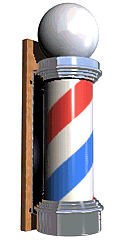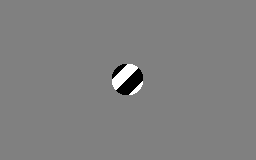Barberpole illusion
Barberpole illusion is a visual phenomenon where a diagonally moving pattern within a vertically or horizontally oriented aperture appears to move along the long axis of the aperture. This illusion demonstrates the complexity of motion perception and how the human visual system interprets movement in a constrained context. The barberpole illusion gets its name from the striped patterns of traditional barber poles, which appear to move upwards even though the stripes are moving around the pole in a helical pattern.
Mechanism[edit | edit source]
The underlying mechanism of the barberpole illusion involves the brain's interpretation of motion signals. In a typical scenario, when a pattern (such as stripes) moves diagonally across a field of view that is restricted (like through a narrow aperture), the true direction of motion is ambiguous. The visual cortex of the brain, specifically areas involved in processing motion such as the MT (middle temporal) and MST (medial superior temporal) areas, tends to favor the interpretation of motion in the direction that aligns with the longest dimension of the aperture. This is due to the aperture problem in visual perception, where the true direction of an edge moving within a narrow aperture cannot be determined; only the component of motion perpendicular to the edge is visible.
History and Research[edit | edit source]
The barberpole illusion has been a subject of interest in the field of psychology and neuroscience for many years, as it provides insights into how the brain processes visual information, especially motion. Research into this illusion has helped scientists understand more about the hierarchical processing of visual stimuli and the integration of local motion signals into a coherent global motion perception.
Applications[edit | edit source]
Understanding the barberpole illusion and the principles behind it has applications in various fields such as neurology, psychology, and computer vision. In neurology and psychology, it helps in understanding how visual processing disorders affect motion perception. In computer vision, insights from studying this illusion can improve algorithms for motion detection and prediction in video processing and autonomous vehicle navigation.
See Also[edit | edit source]
Navigation: Wellness - Encyclopedia - Health topics - Disease Index - Drugs - World Directory - Gray's Anatomy - Keto diet - Recipes
Search WikiMD
Ad.Tired of being Overweight? Try W8MD's physician weight loss program.
Semaglutide (Ozempic / Wegovy and Tirzepatide (Mounjaro) available.
Advertise on WikiMD
WikiMD is not a substitute for professional medical advice. See full disclaimer.
Credits:Most images are courtesy of Wikimedia commons, and templates Wikipedia, licensed under CC BY SA or similar.
Contributors: Prab R. Tumpati, MD



